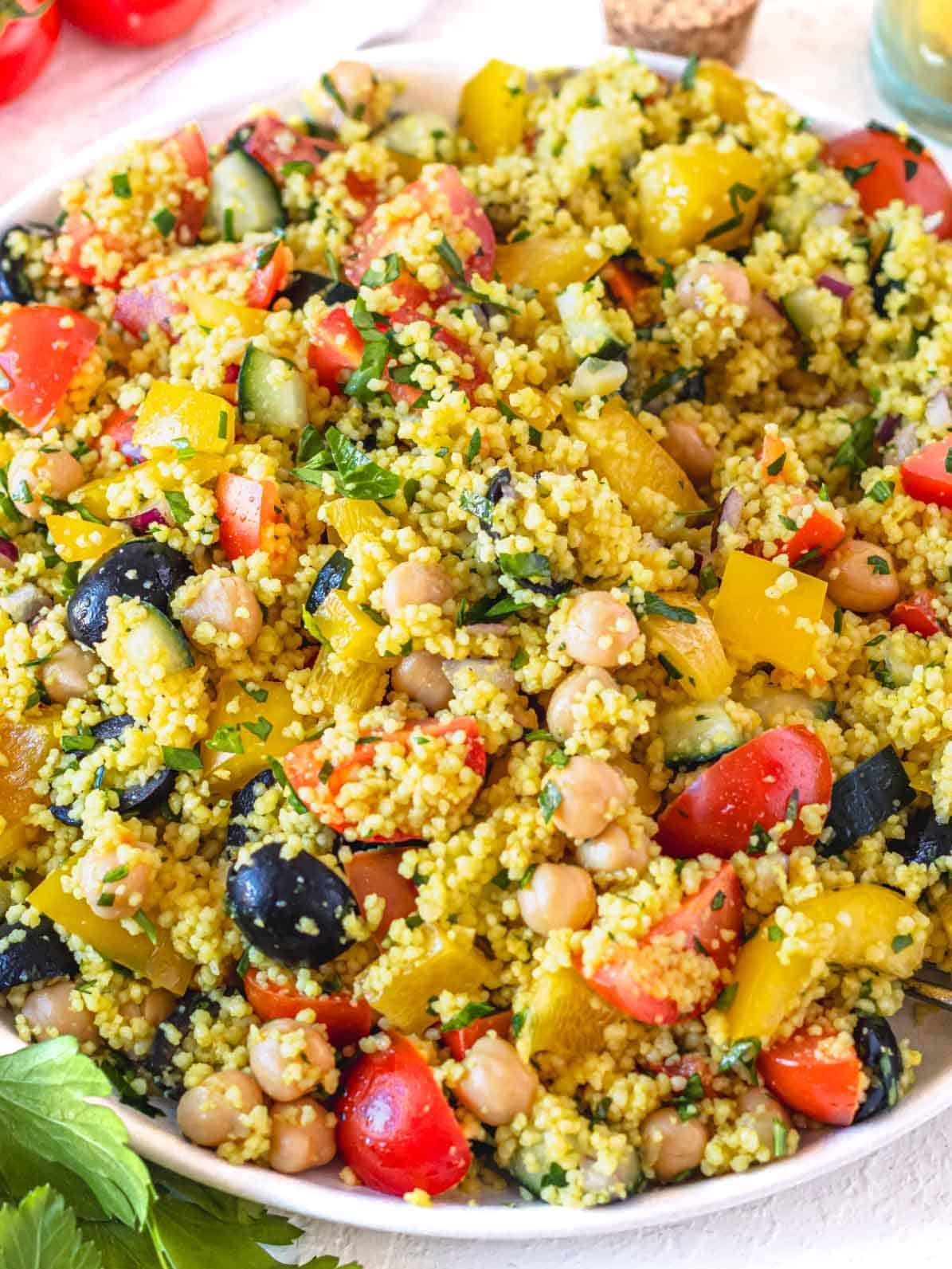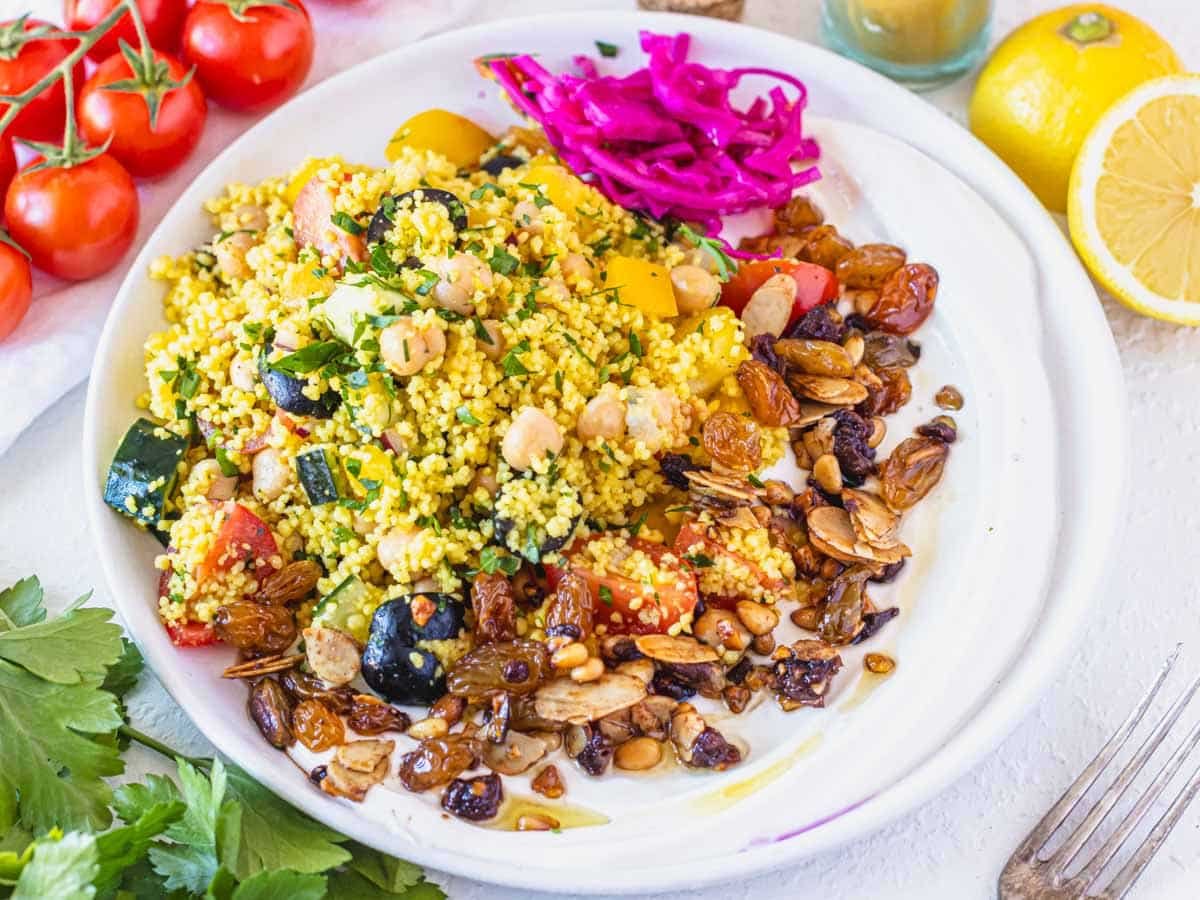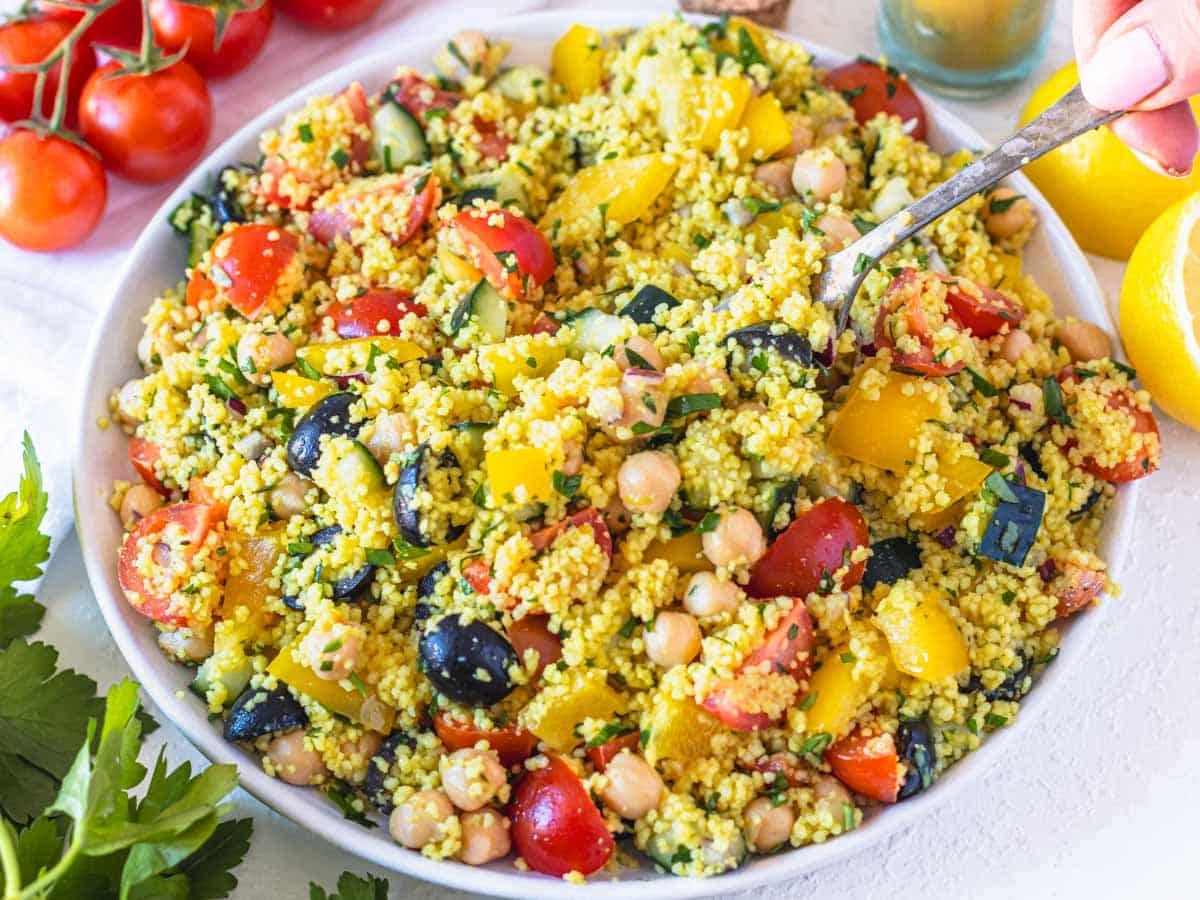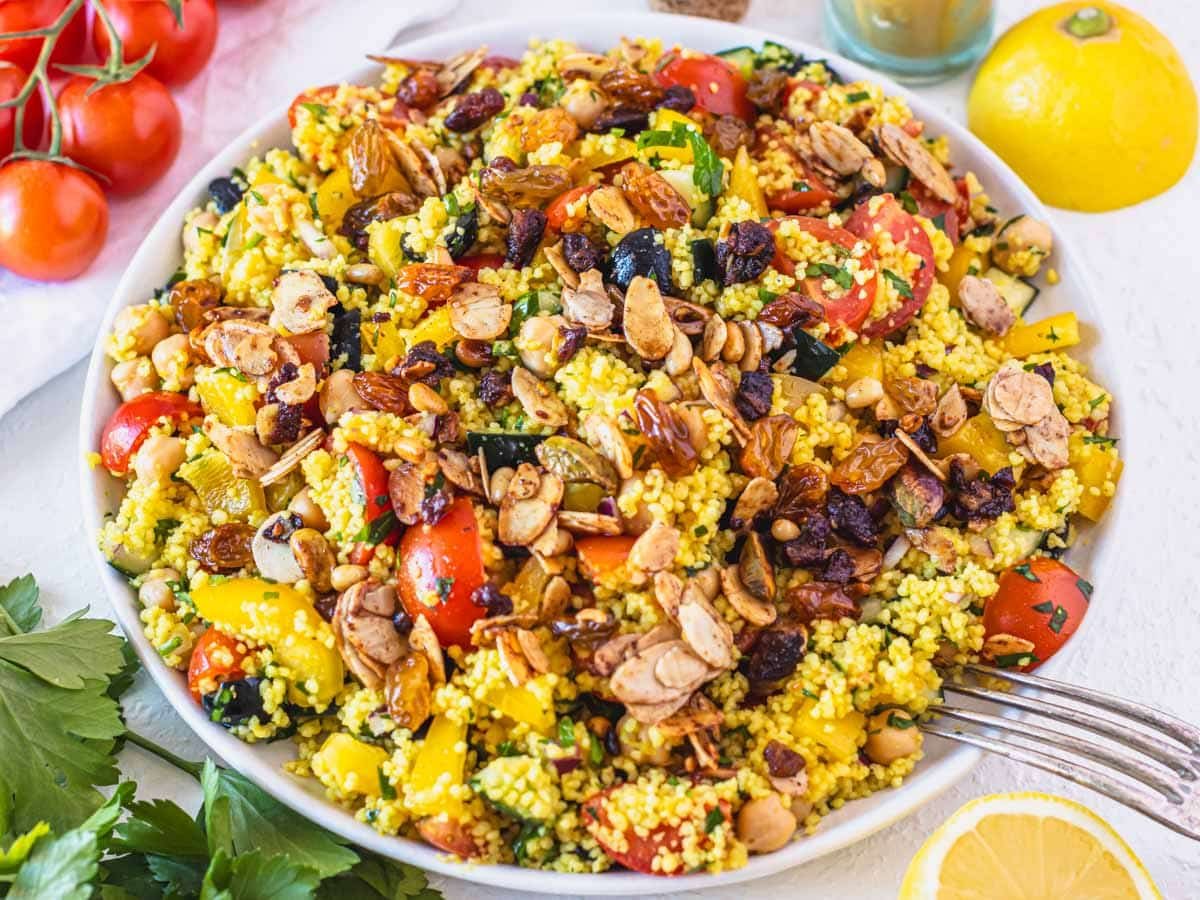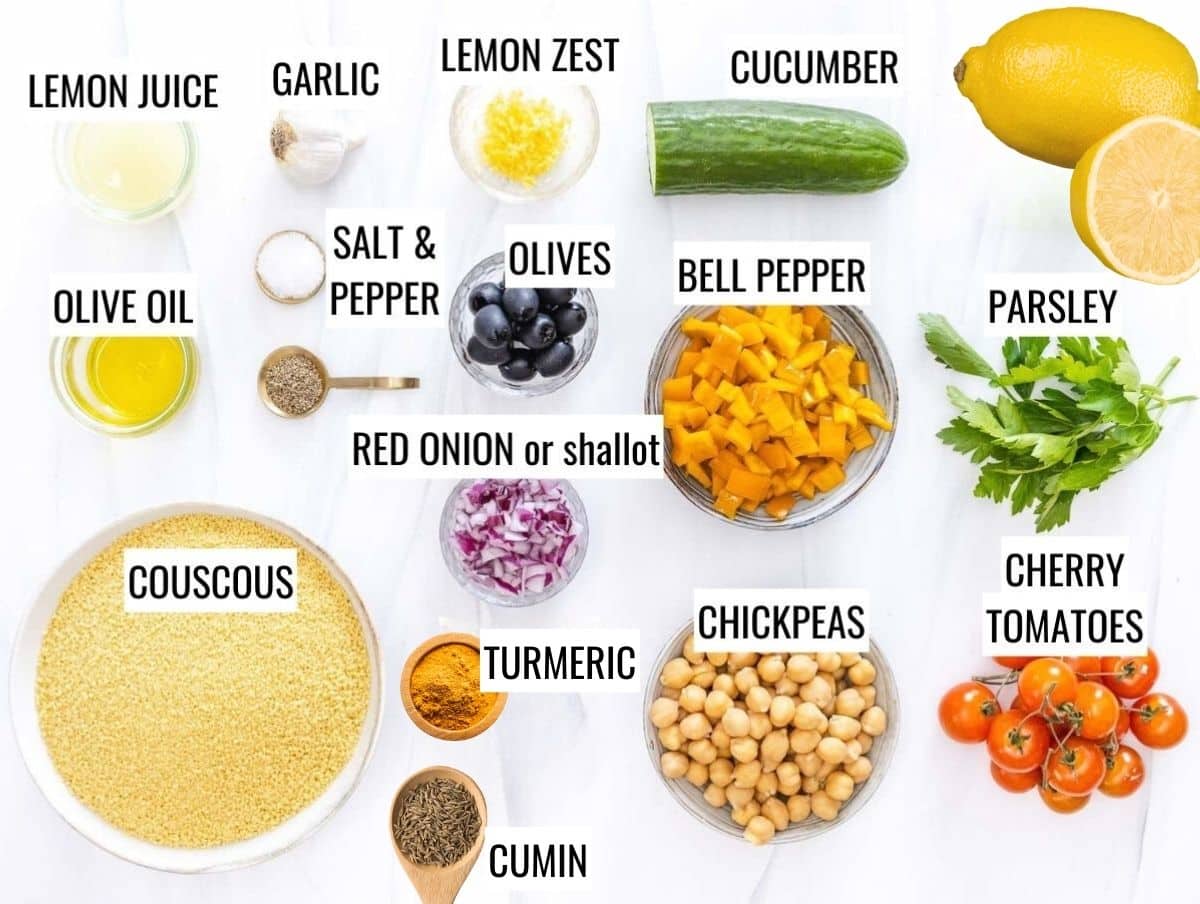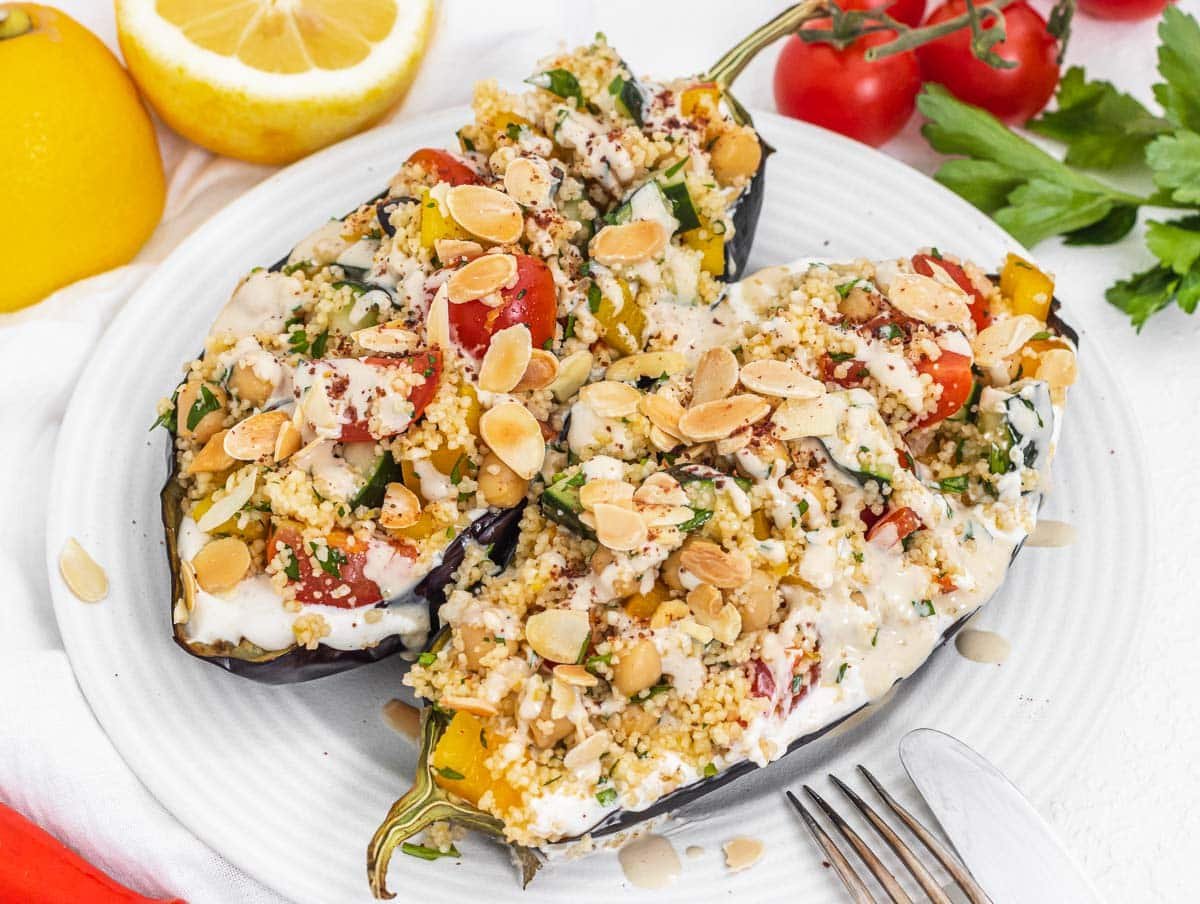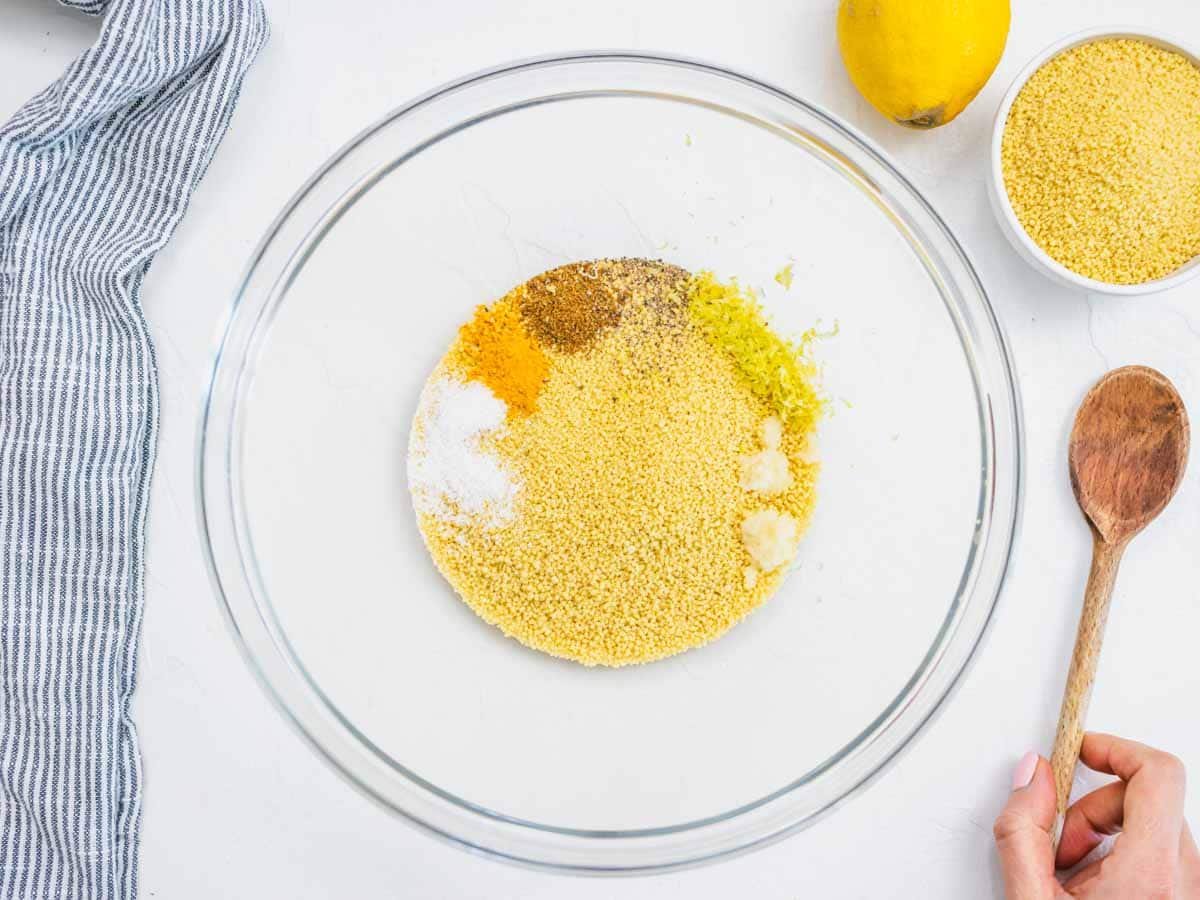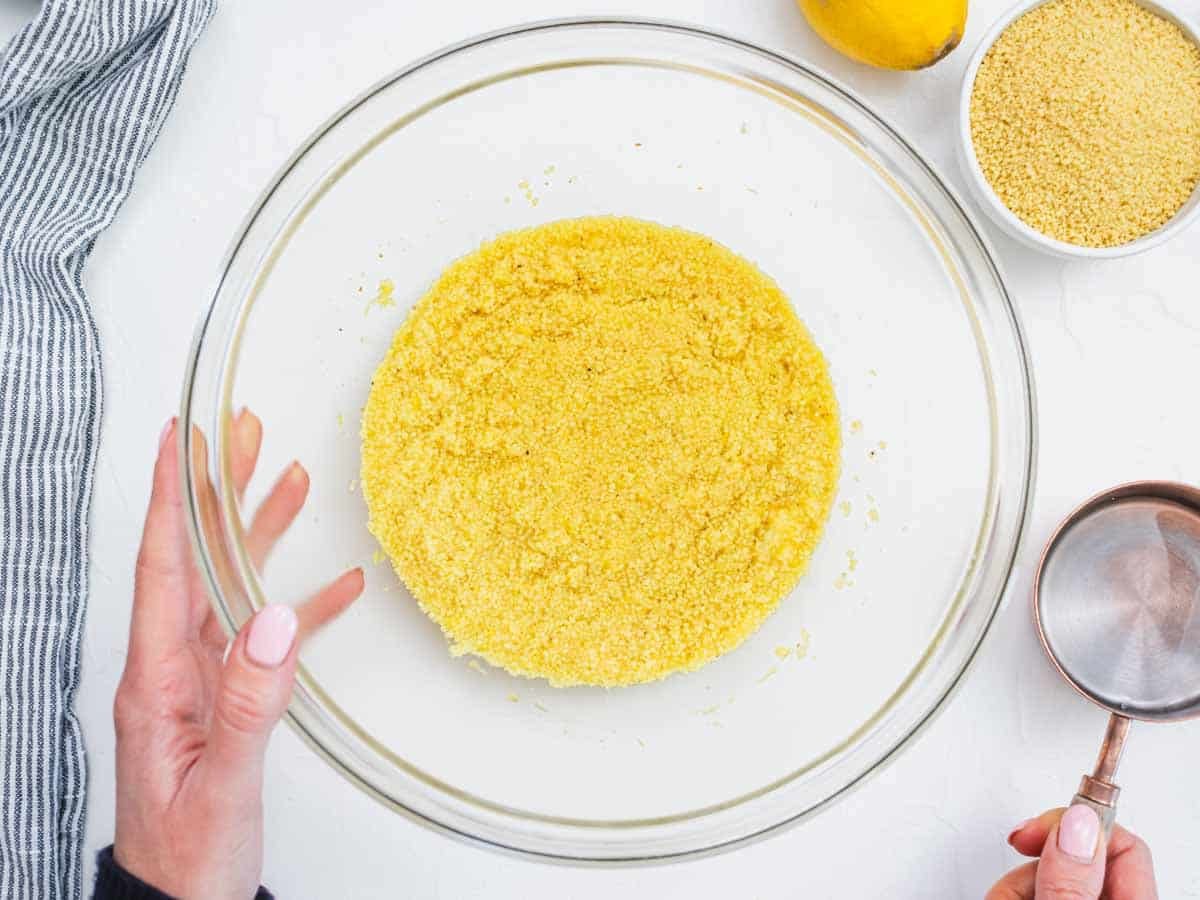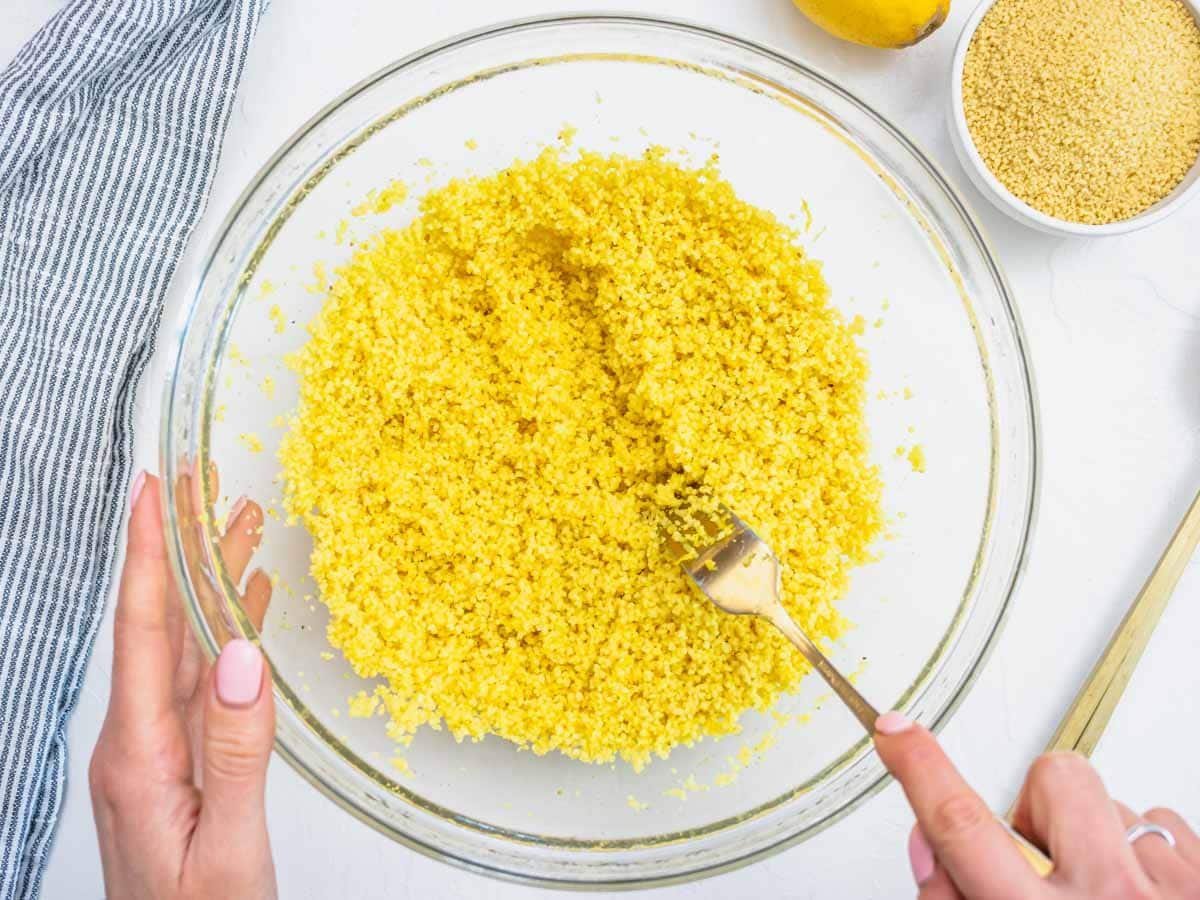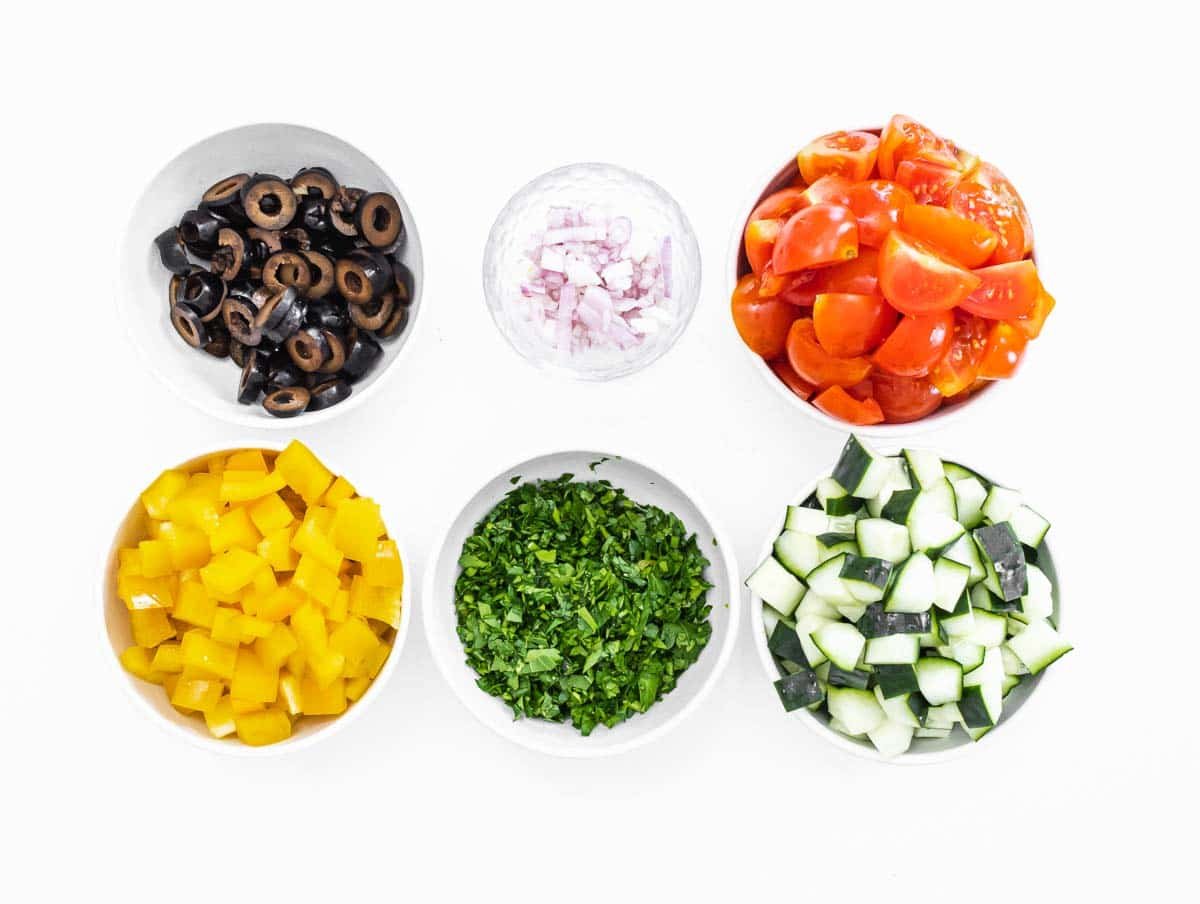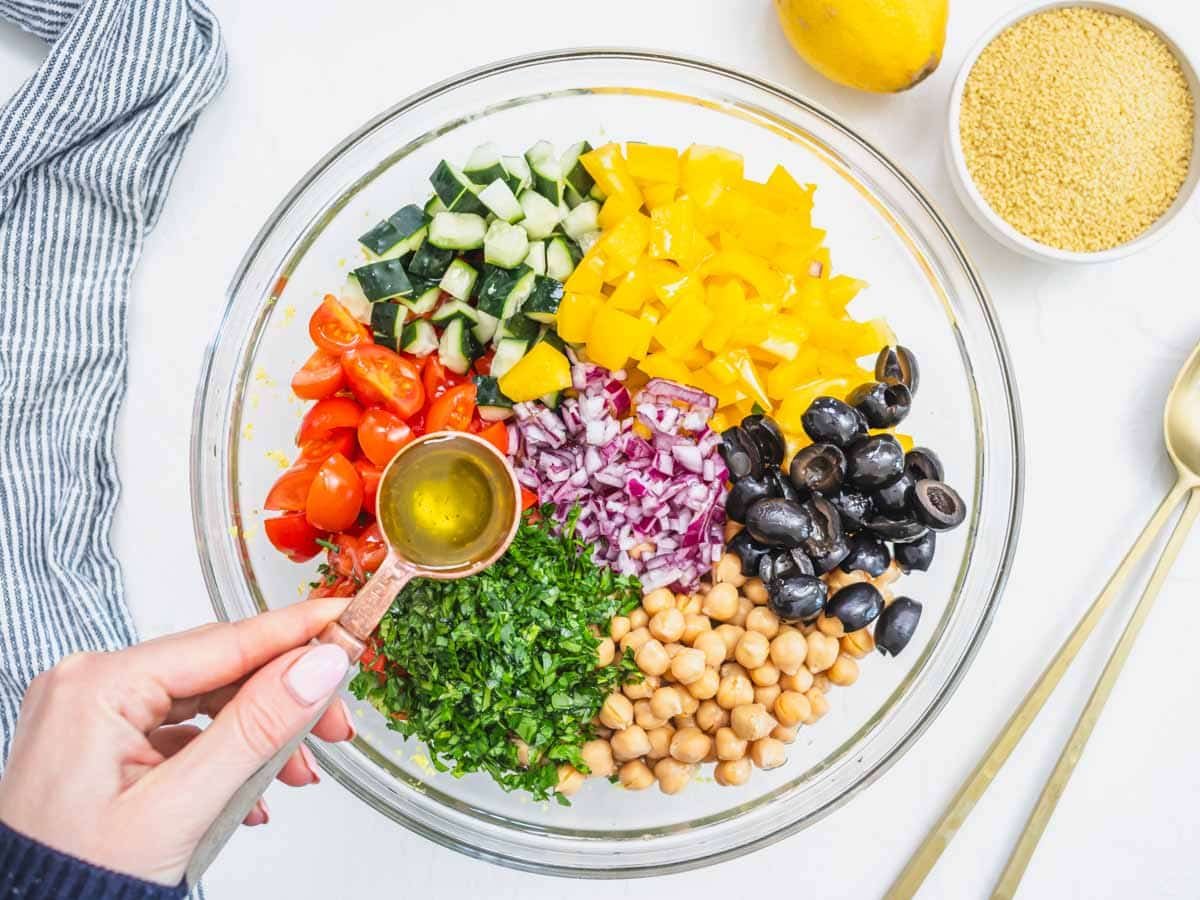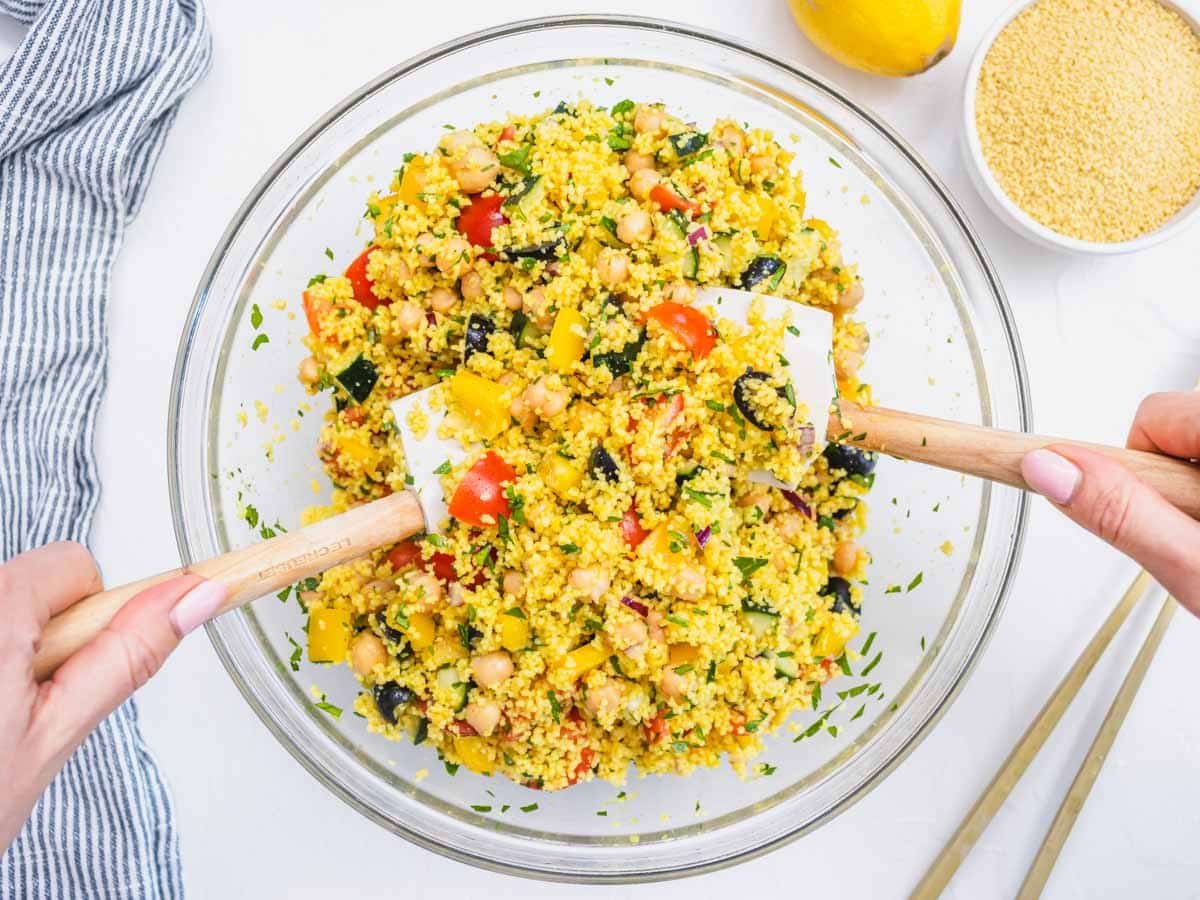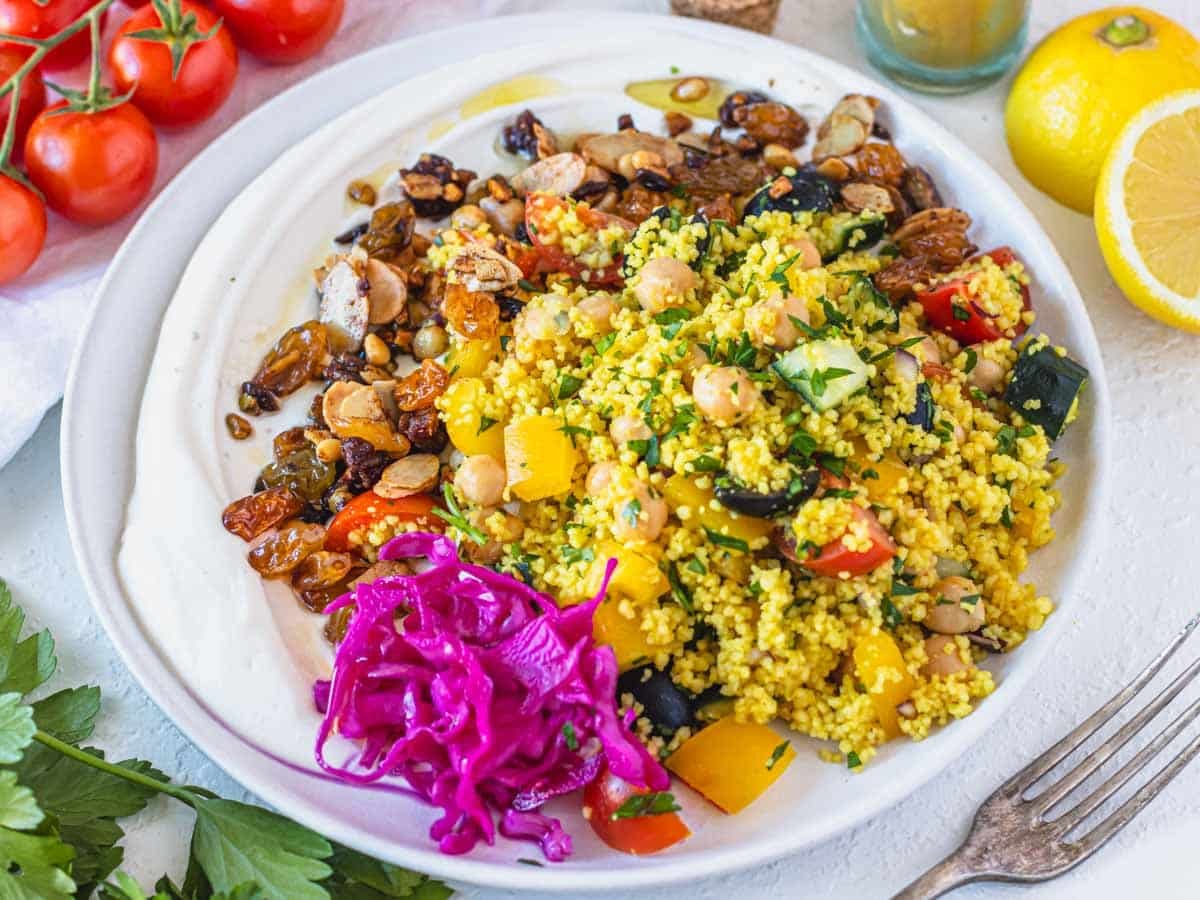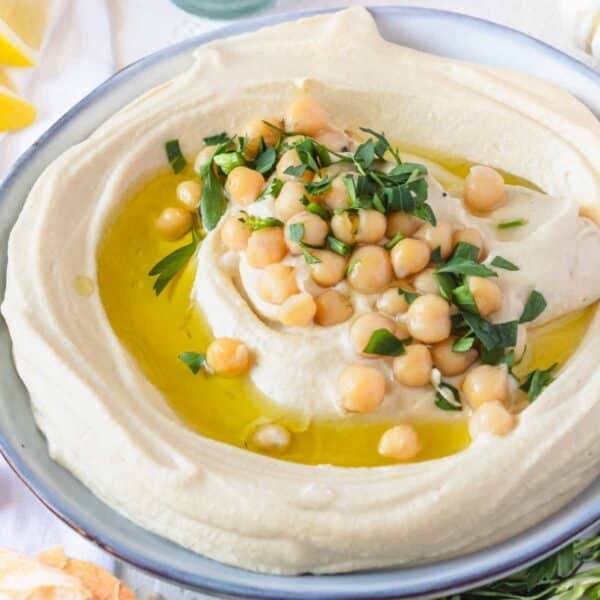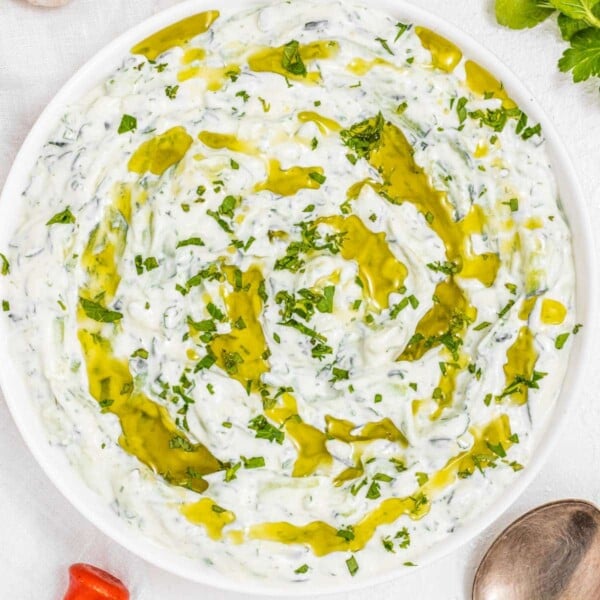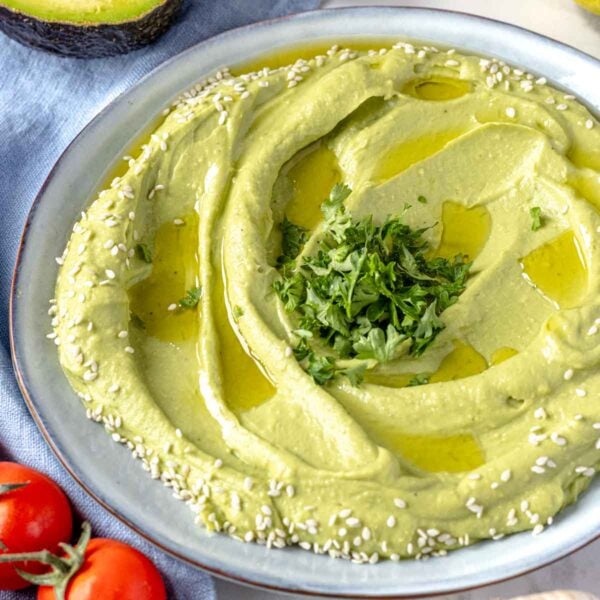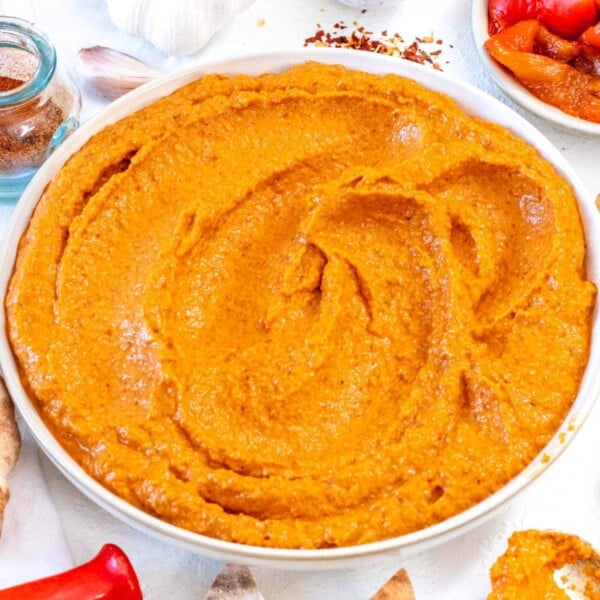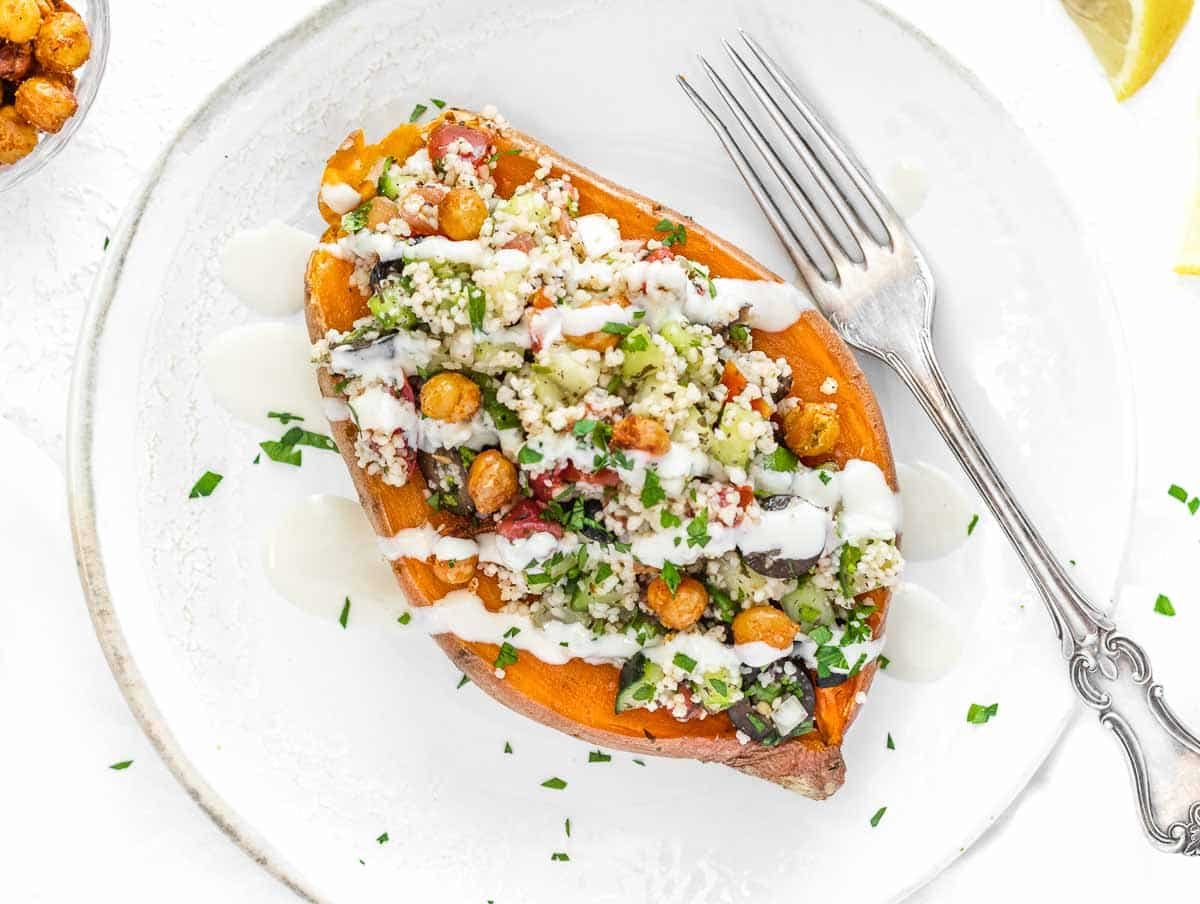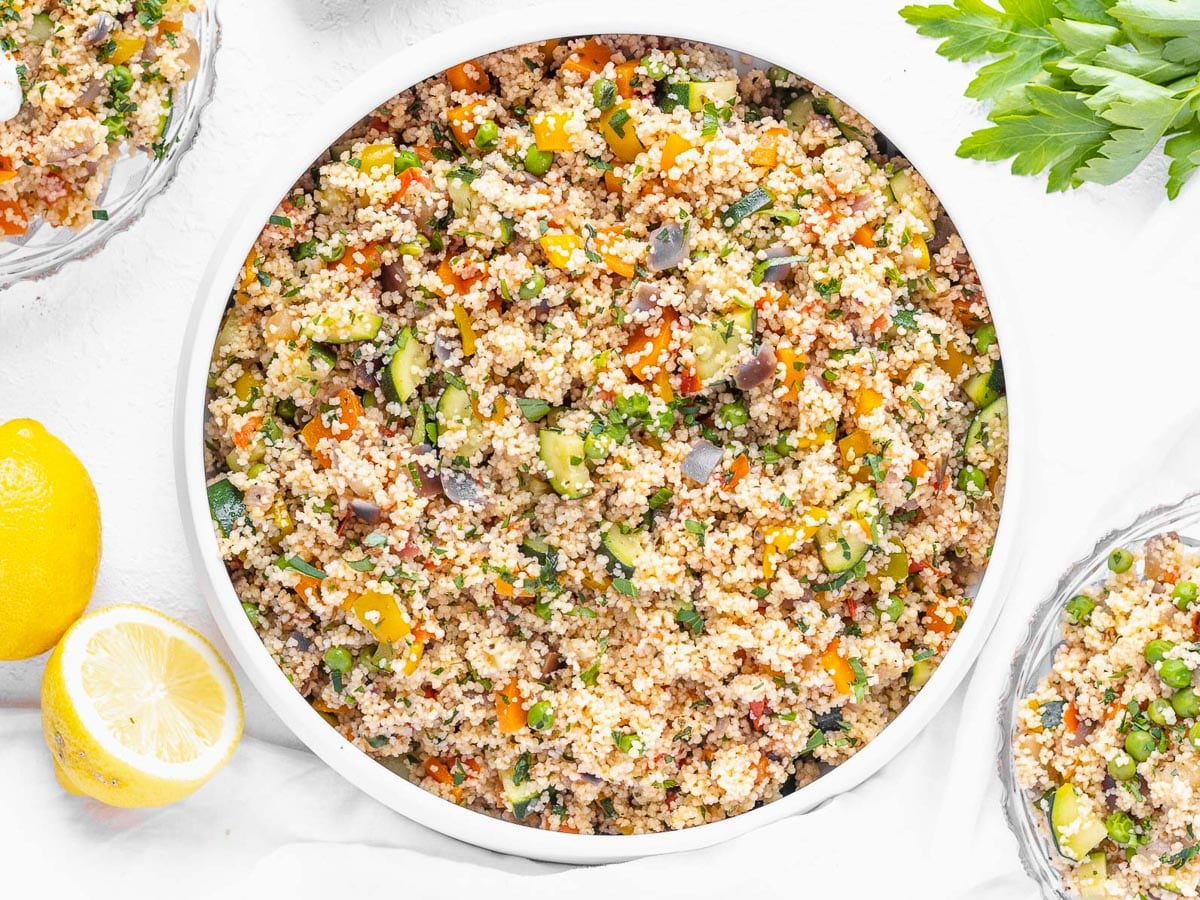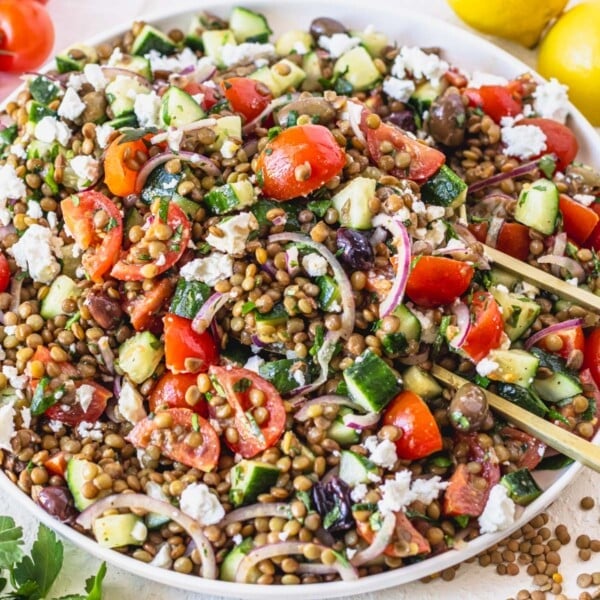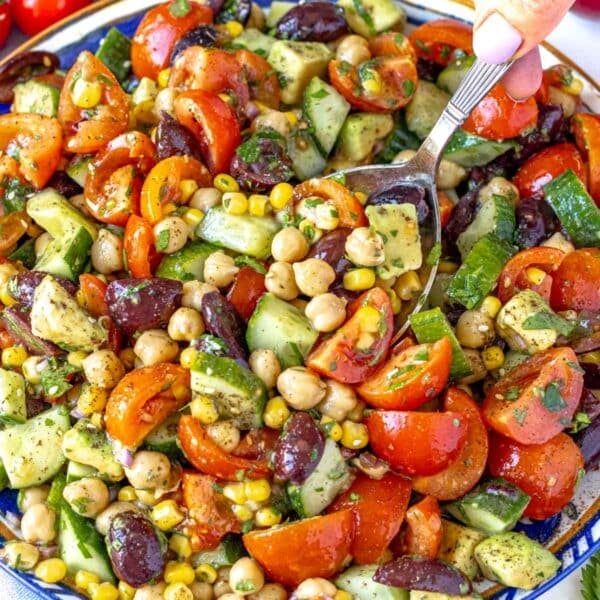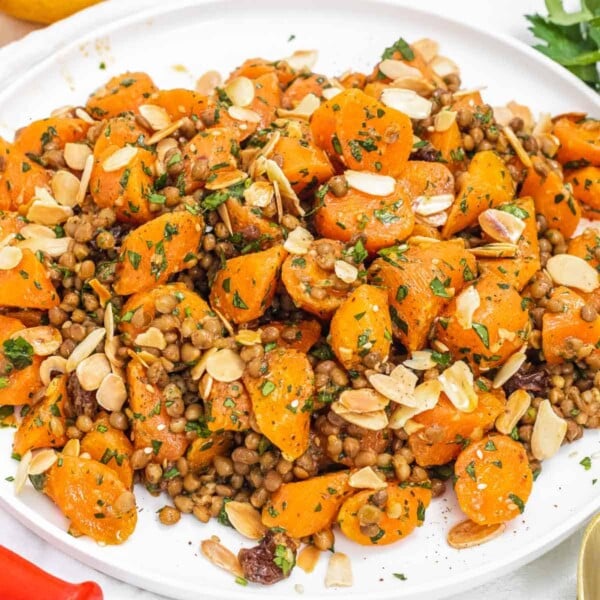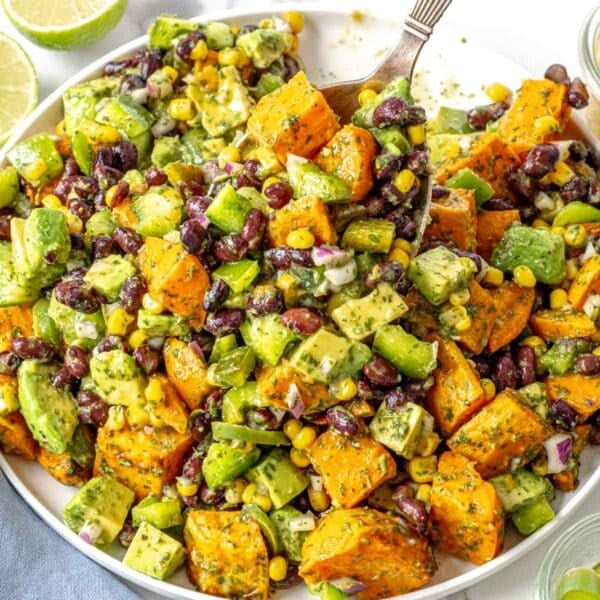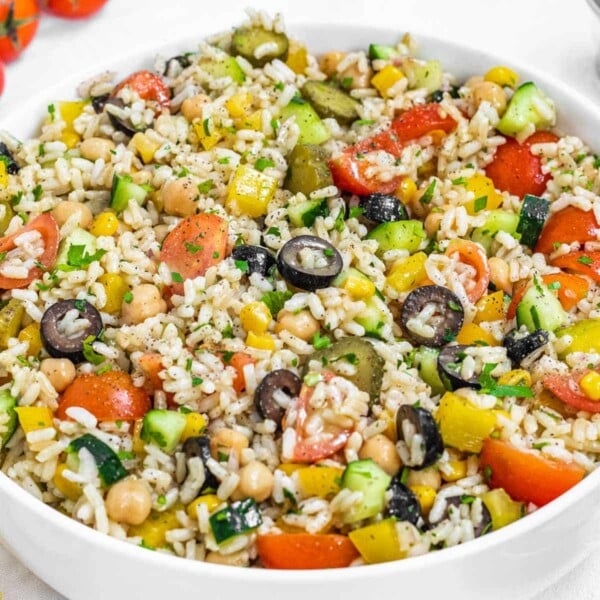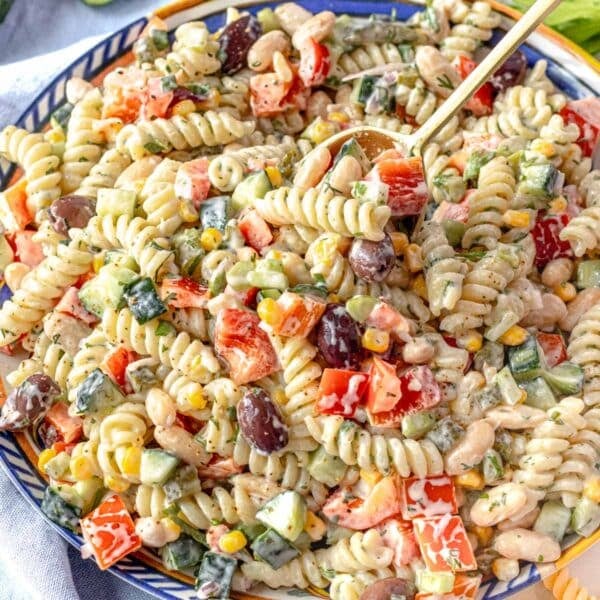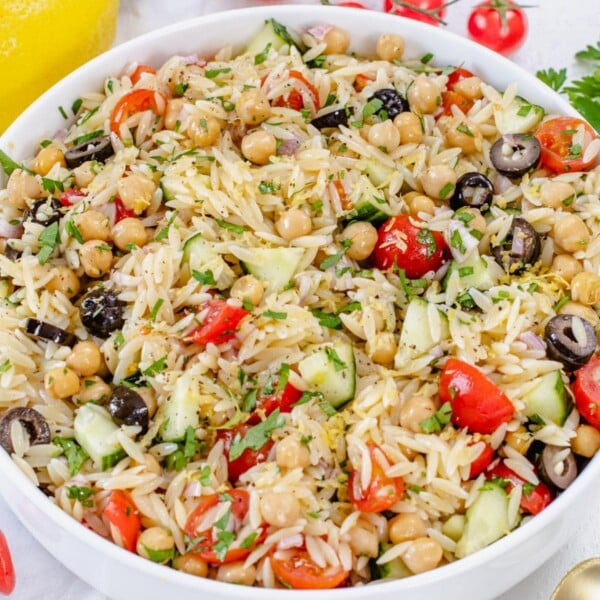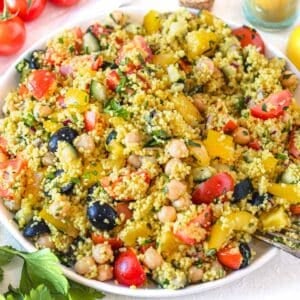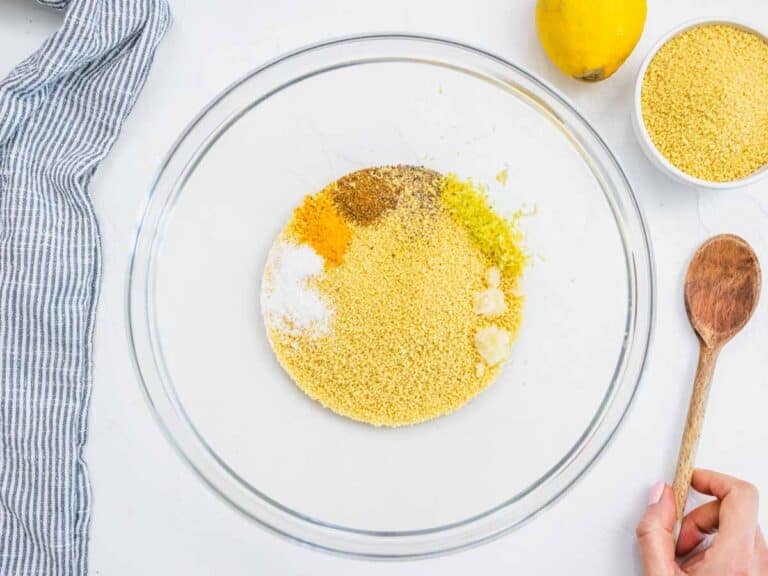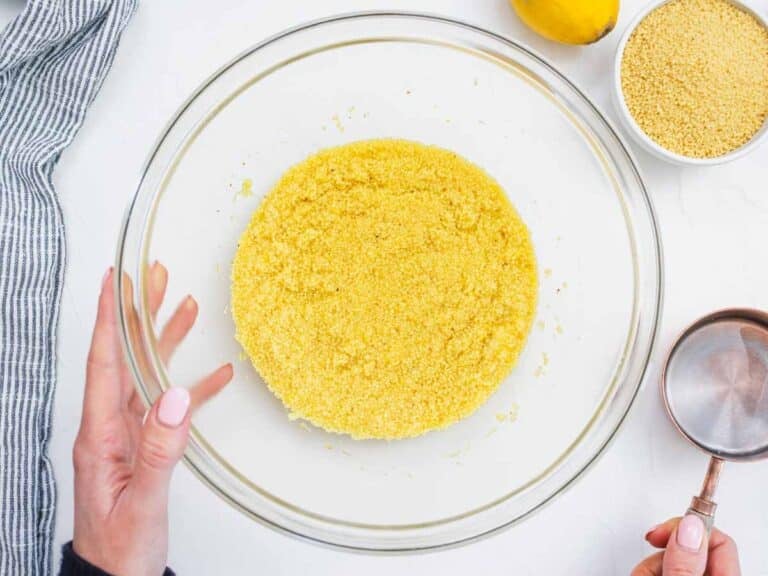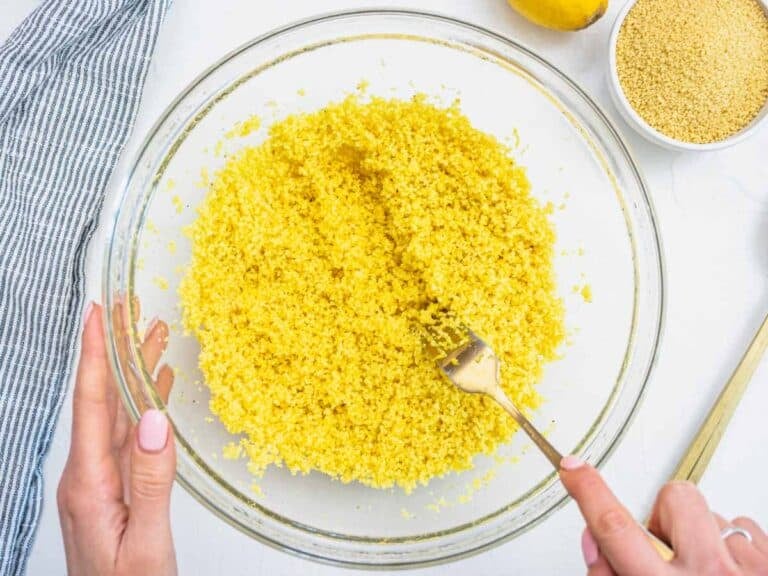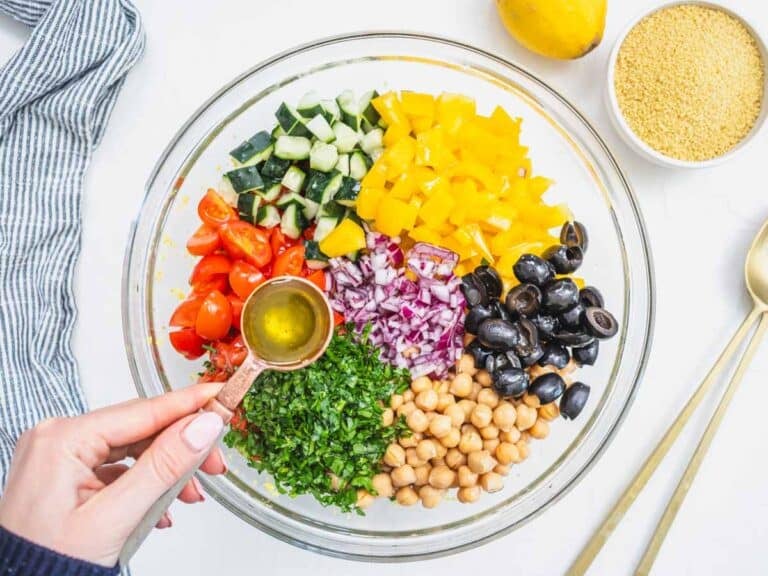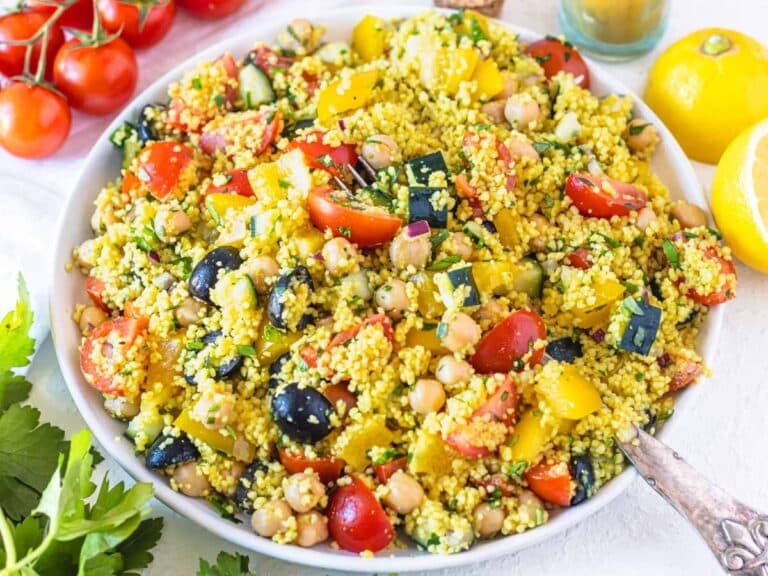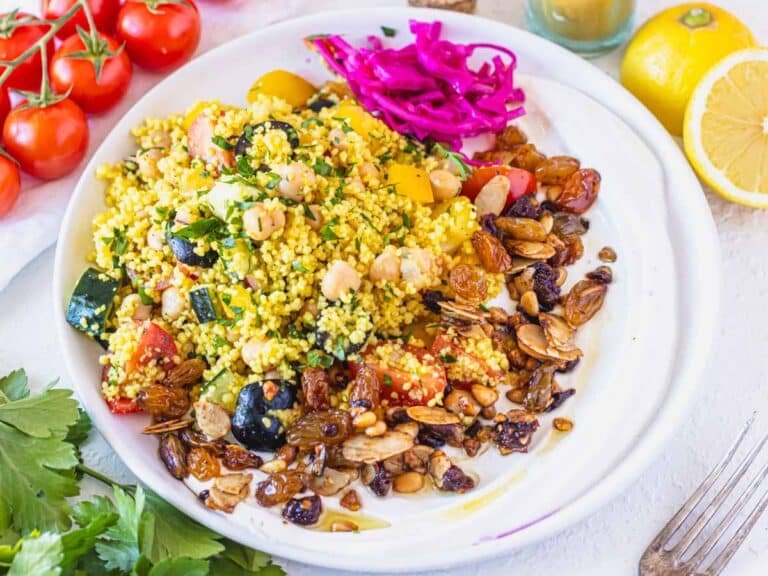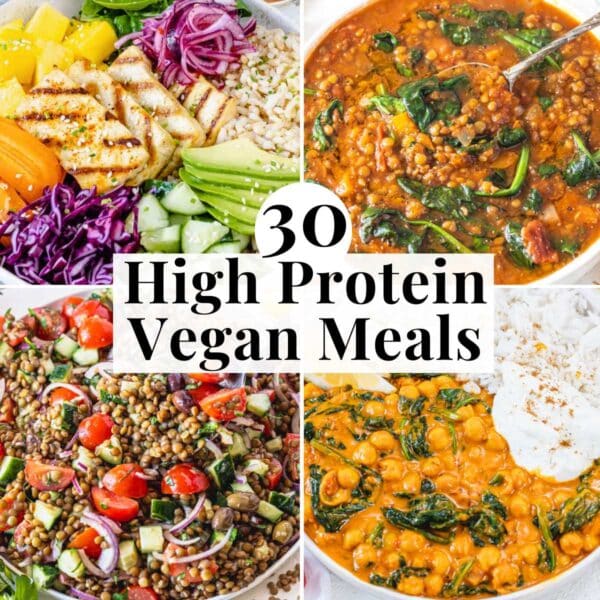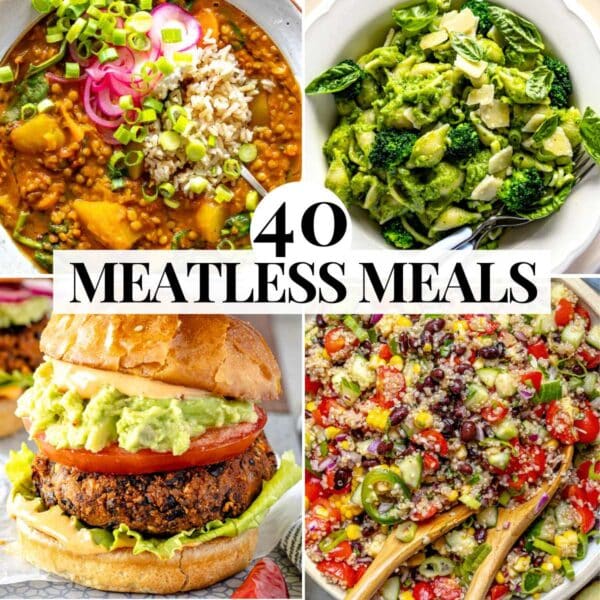You’ll love the freshness and simplicity of this recipe. You can make it in one bowl in the time it takes you to cut the vegetables. Dietary Note: this recipe is suitable for a vegetarian and vegan, and gluten-free diet. It’s low in cholesterol and saturated fats.Don’t have time to read the full blog post? JUMP TO RECIPE HERE!
What is couscous salad?
Couscous salad video
Ingredients and Substitutions for Couscous Salad
How to Make Couscous Salad
Serving Suggestions
Variations
Storage & Make Ahead
More Easy Salads
More Grain Bowls & Pasta Salads
As you learned in our guide on how to cook couscous, you can prep it in 5 quick minutes in a bowl with hot water. You guys loved it with our Moroccan carrot salad and Moroccan chickpea stew, and many of you also enjoyed it with lentil tabbouleh, lentil salad, and whole roasted cauliflower with chermoula sauce. For this couscous salad recipe, we took inspiration from traditional Moroccan couscous, prepared with a pinch of turmeric or saffron to make it look gorgeously golden. Unlike our warm couscous salad with vegetables, this refreshing salad is served at room temperature and seasoned with a simple but delicious olive oil, lemon, and lemon zest dressing. Add a pinch of cumin, fresh parsley, and grated garlic to the couscous to stay true to Mediterranean and Moroccan flavors. You’ll love the zesty, fresh, and aromatic taste! Follow our step-by-step recipe, and in less than 20 minutes, you’ll have a delicious and versatile couscous salad excellent for a quick lunch, healthy dinner, side dish, meal prep, potlucks, picnics, and barbecues.
Couscous
You’ll need regular couscous (Moroccan couscous), which looks like tiny granules of pasta. You can substitute whole-wheat couscous for regular couscous. You’ll also need hot water to cook the couscous. If you want a salad with a richer flavor, you can substitute reduced-sodium vegetable stock for the water. Note: To make an Israeli couscous salad, substitute pearl couscous (Israeli couscous) for regular couscous. In this case, cook the pearl couscous per package instructions before mixing it with the other ingredients.
Flavor and Color
Couscous has a neutral flavor and a pale color. To make it tastier and more appealing, season it with:
Sea salt & freshly ground black pepper Turmeric powder (or a pinch of saffron) Ground cumin Grated garlic Grated lemon zest
Mix these ingredients with the dry couscous before adding the hot water. It’s a simple trick we learned during our travels, and it’ll infuse the couscous with a beautiful aroma and golden color.
Extra virgin olive oil
Extra virgin olive oil is traditionally used around the Mediterranean, where olive trees abound. You’ll love the fragrance of extra virgin olive oil that touches the warm couscous. They go so well together.
Lemon juice
Freshly squeezed would be best. It adds freshness and tanginess. However, if you are more into sweeter flavors, you can use orange juice instead. If you can’t find lemons or oranges or want to try something else, you can use red wine vinegar, white wine vinegar, or apple cider vinegar.
Chickpeas
You can use canned or dry chickpeas that you previously soaked and cooked. Here’s our guide on how to cook chickpeas, where we explain how to do that. We always like to add a legume to this Mediterranean couscous salad because 1) legumes are a staple in Mediterranean countries, 2) they are protein-rich, and 3) they contain plenty of gut and heart-healthy fiber. Substitute cannellini beans, black beans, or lentils for chickpeas.
Cherry tomatoes
You can use cherry tomatoes, date tomatoes, plum tomatoes, or another small tomato type. They add a touch of sweetness to the salad.
Onion or Shallot
Finely chopped red onion or shallot add sweet and tangy notes to the couscous salad. Substitute green onions, radishes, or white onions.
Cucumber
We add cucumber for freshness and crunch. You can replace it with diced green or red bell peppers or thinly sliced fennel.
Bell pepper
We use yellow bell pepper to add sweetness, crunch, and a vibrant yellow color. Substitute red bell pepper or canned corn.
Olives
They add umami to this Mediterranean couscous salad. It’s easier if you use pitted olives, black or green. For a fancier salad, opt for kalamata olives or taggiasche olives. Substitute marinated artichokes or chopped sundried tomatoes for olives.
Parsley
Flat-leaf parsley is the variety used in the Mediterranean area. If you can’t find it, feel free to use the curly type. Other dried and fresh herbs that are good with couscous are fresh mint, fresh basil, dill, and dried oregano. You can mix more herbs if you like; they are delicious together.
Serves well with (optional)
Crumbled feta cheese or non-dairy feta. Yogurt tahini sauce or tahini sauce. Roasted eggplant or microwave sweet potato. Tzatziki sauce. Pine nuts, toasted on a pan until golden brown. Raisins, chopped dates, and slivered almonds sautéed in olive oil and cinnamon. Quick pickled red onions, red cabbage, or jalapeños.
1. Cook the couscous
To a large mixing bowl, add the dry couscous, grated lemon zest, grated garlic, ground cumin, turmeric powder, salt, and black pepper. Stir well with a fork or wooden spoon until combined. Boil the water in a kettle or a pot, then pour it over the couscous. Stir with a fork to ensure that the water covers the couscous, cover it with a plate, and set aside for 5 – 10 minutes (in the meantime, you can chop the veggies). When the couscous fully absorbed the water, fluff with a fork to separate the granules. To do that, gently scrape or rake the granules with the tips of a fork until there are no lumps and the couscous granules are all separated and fluffy.
2. Cut the veggies
Remove the stem and seeds of the bell pepper, then chop it into small dice. Cut the cherry tomatoes into quarters. Cut the cucumber in half, then each half in half again, and slice into triangles. Finely chop the shallot or red onion. Cut the olives into thin slices or in half. Finely chop the parsley. Drain and rinse the chickpeas.
3. Mix the salad
Add the chopped vegetables and the chickpeas to the bowl with the couscous. Season with extra virgin olive oil and lemon juice and mix well until all ingredients are well combined. Taste and adjust for salt, olive oil, and lemon juice before serving. It’s excellent for a quick lunch or healthy dinner, or you can bring it to potlucks, barbecues, and picnics. Turn the salad into a delicious meal by serving it with:
Yogurt tahini sauce. Quick pickled red onions or red cabbage. Moroccan dried fruit and nut mix.
Other sauces/spreads/dressings you can serve this couscous salad with are:
Tahini sauce Guacamole Cashew sour cream Romesco sauce Tzatziki Avocado spread Hummus
Hummus
Tzatziki
Avocado Spread
Romesco Sauce
Stuffed eggplants Microwave sweet potato Stuffed bell pepper
Greek couscous salad
Add crumbled feta in the mix with the other ingredients, and you’ll have a delicious Greek couscous salad.
Warm couscous salad
Our couscous with vegetables is a delicious warm couscous salad with eggplant, zucchini, and other delicious vegetables. We cook the veggies in a pan with olive oil and herbs to make them super tasty before mixing them with the couscous. Check out our warm couscous salad recipe.
Couscous black bean salad
You guys loved our black bean salad with sweet potatoes, corn, avocado, and cilantro lime dressing. Well, couscous black bean salad is the same recipe but with added couscous in the mix. It’s delicious and a must-try for black bean and cilantro lovers. Check out our black bean salad recipe and add a cup of cooked couscous. The next day, the salad is even tastier as the flavors have time to meld. Refrigerator: Keep the salad in a bowl covered with a plate or in an airtight container in the fridge for up to 3 days. To maximize its flavor, take it out of the refrigerator 30 minutes before serving it. Freezer: We don’t recommend freezing the salad as the fresh veggies would lose texture and crunch.
Lentil Salad
Chickpea Salad
Lentil Carrot Salad
Black Bean Salad
Rice Salad
Vegan Pasta Salad
Creamy Pasta Salad
Orzo Salad
30 High Protein Vegan Meals
45 Easy Vegetarian Dinner Recipes
40 Easy Meatless Meals
30 High Protein Vegetarian Meals
